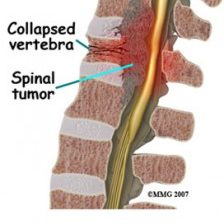Spinal Tumors Treatment
For Dynamic Stabilization And Back Pain Relief
In order to understand spinal tumors, it is necessary to break them down into several categories. Tumors of the spine are broken down into the aggressiveness of the tumor cell, whether they are benign or malignant and their location.
Tumor Type by Location:
• Located outside of the covering of the spinal cord and nerves, they are known to be extradural.
• inside the covering of the spinal cord but outside of the spinal cord itself, they are known as intradural extramedullary. Intradural extramedullary spinal cord tumors include meningiomas and neurofibromas.
• Within the spinal cord itself, they are known as intramedullary spinal cord tumors. Intramedullary spinal cord tumors include astrocytomas and ependymomas.
Spinal tumors may also be broken down according to their origin:
• If they started growing from within the spine or spinal cord itself, they are known as primary tumors. Primary spinal tumors such as chordoma and osteoblastoma are not as common as secondary or metastatic tumors.
• If they spread from another part of the body to the spine or spinal cord than they are known as secondary or metastatic tumors. Common metastatic tumors include lymphoma, lung, breast, and prostate.

Tumors of the spine generally cause pain. The pain can be localized to the part of the body or spine where the tumor is located, or it may appear to be coming from an arm or leg, depending on which nerves are being compressed or compromised by the tumor. The tumor may also cause paralysis of the legs or arms depending on whether or not there is spinal cord compression. Bowel and bladder function may also be compromised.
As with most tumors in the body, the cause is usually not identifiable.
The diagnosis of tumors affecting the spine can be accomplished with x-rays of the spine as well as MRI and CT scans. At times a myelogram followed by a CT scan may be beneficial. In order to obtain a diagnosis, a biopsy may be undertaken if there is no known source of the tumor outside of the spine. At other times, open surgery on the spine or spinal cord, or nerve roots may be necessary.
The treatments for tumors affecting the spine are varied, depending upon the location of the tumor, the type of the tumor cell, the stability of the spine, and the neurological condition of the spinal cord and patient.
The sensitivity of the tumor to radiation treatments will also affect the decision as to whether to undergo a large surgical procedure. Surgery may consist of simply a biopsy or a more extensive section of the tumor.
If the tumor is within the spinal cord itself, surgery may consist of opening up the spinal cord and attempting a total removal of the tumor. If the tumor involves a nerve root outside the spinal cord, an attempt at total removal may be performed. If the tumor has affected the bone and compromises the strength and integrity of the spine, a decompression and possible fusion of the spine may be needed. Any surgical intervention may be followed by radiation and chemotherapy.
The prognosis varies depending on the nature of the tumor cells, their aggressiveness and the sensitivity of the tumor to radiation and chemotherapy. In the case of benign tumors, the prognosis may differ due to the degree of surgical removal of the tumor and whether any neurological function has been compromised.